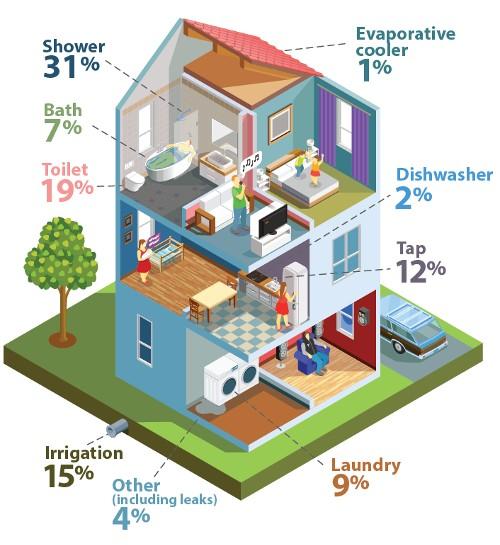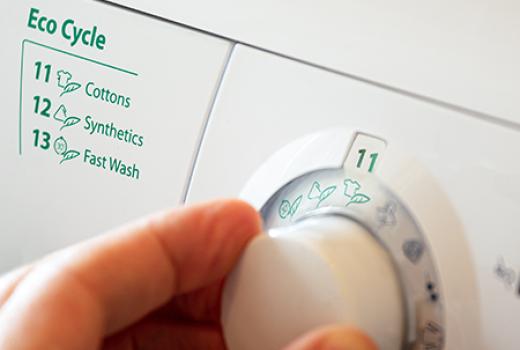Brimbank is a growing municipality. There are more and more pressures on our precious water supplies. Freshwater scarcity is posing a major problem around the world and we can all do our bit to help secure its future.
What are the current rules and restrictions to help us use water more efficiently?
Greater Western Water has outlined some rules and restrictions for using water responsibly. To better prepare your family for a drought, visit their Drought Preparedness Plan.
Target 150
Did you know about the Target 150 campaign? 150 litres is the maximum amount of water each of us should try to use each day. On average Melburnians consume 162L/person/day. In 2019/2020 Brimbank residents consumed 157L/person/day.
Here is how your 157 litres of water is used each day:

Image supplied courtesy of City West Water. Figures based on City West Water’s report Residential End Use Measurement Study (August 2017 - July 2018).
Make Every Drop Count
Make Every Drop Count aims to encourage water conservation and mindful water use. It is an initiative of City West Water, Melbourne Water, South East Water and Yarra Valley Water.
Find out why water conservation matters and what you can do in the bathroom, laundry, kitchen and outdoors. There are lots of ways to save our precious water.
In the bathroom
Did you know that about 50 per cent of all water used in the home is in the bathroom?
| What you can do | Further information and resources |
|---|---|
| Take shorter showers (aim for 4min or less). | video or use your favourite song as a shower timer. |
| Exchange your showerhead for a more water-efficient one. |
|
| Turn the tap off when brushing your teeth. | Make Every Drop Count website or spend 5 minutes in the Smart Approved WaterMark blue house to find out how easy it is to save water. |
| Use the half flush button on the toilet (when you can!) | Check if your toilet leaks. |
In the kitchen
We use about 10 per cent of our household water in the kitchen but these little changes can make a big difference:
| What you can do | Further information and resources |
|---|---|
| Wash vegetables in a container, not under running water. | Visit the Make Every Drop Count website. |
| Put your dishes straight in the dishwasher (no rinsing) and only run your dishwasher with a full load. | For dishwasher tips visit Smart Watermark or the Make Every Drop Count website. |
| Catch running water while waiting for it to warm up and use it to water plants or top up pet bowls. | Visit the Make Every Drop Count website. |
| Only put the dishwasher or washing machine on if you have a full load and use the eco settings. | For further smart water advice and water-saving videos check out Smart Watermark. |
| If you're in the market for a new machine, choose a water efficient dishwasher. | Water Efficiency Labelling and Standards Scheme (WELS) We use the Water Efficiency Labelling and Standards Scheme. This scheme uses a six-star rating system to rate a product's water efficiency. Check the star ratings of your water appliances to help reduce your bill and save water. |
In the laundry
The laundry consumes about 10 per cent of a household’s water use. On top of that, washing machines use lots of energy and detergents.
Try these tips to cut down your water use in the laundry:
| What you can do | Further information and resources |
|---|---|
| Use the eco setting on your washing machine and always make sure you have a full load. | Visit the Make Every Drop Count website. |
| If you're in the market for a new machine, choose a water efficient front loader. | Water Efficiency Labelling and Standards Scheme (WELS) We use the Water Efficiency Labelling and Standards Scheme. This scheme uses a six-star rating system to rate a product's water efficiency. Check the star ratings of your water appliances to help reduce your bill and save water. |
| Check taps for leaks and install water efficient tapware | Visit Smart Approved Water Mark and search for taps. |
Outdoors
Go easy with the hose! Outdoor water use accounts for a hefty percentage of the average home’s water use.
Here are some handy hints to help save our precious water:
| What you can do | Further information and resources |
|---|---|
| When washing your car at home, use a bucket in the front yard to reduce waste. | Visit the Make Every Drop Count website. |
| Use a pool cover to reduce evaporation. | Visit the Make Every Drop Count website. |
| Install a rainwater tank and connecting to your toilet and/or garden. | Check out My Smart Garden Water section to find out more about grey water regulations and tips on detergents to use. |
| Use your grey water on the garden (using an enviro-friendly detergent). | Check out My Smart Garden Water section to find out more about grey water regulations and tips on detergents to use. |
| Plant flowers that use less water and water your garden at dusk or dawn. | Visit My Smart Garden website to find out what to plant. |
| Mulch your garden to reduce evaporation by up to 70%. | Sustainable Gardening Australia has more water conservation and irrigation ideas. |
What else can you do to help?
- Measure your water use at home to conserve water. Check your latest City West Water bill or use an interactive online calculator.
- Check out Greater Western Water for more ways to save money on your water bill.
- If you speak English as an additional language (EAL) there are resources for you to learn about water and understand your water bill in your language.
- The Victorian Energy Upgrades program is available to every Victorian household. Save money on the installation of water and energy-efficient products, reduce your water and energy bill, and help the environment by getting involved in Victorian Energy Upgrades.
Improving the quality of our water
‘Stormwater’ is a surface run-off from rain and storm events that enters the drainage system. The water picks up pollutants like litter, leaves, sediment, and oils. See the Environmental Protection Authority's for types and causes of stormwater pollution.
You can be a local hero of waterways!
How can we protect our waterways and reduce pollutants in stormwater?
- Checking your stormwater drains and making sure they are clear of litter and waste
- Using eco-friendly fertilisers and pesticides in the garden
- Dispose of your waste water properly, which includes not allowing chemicals like paint, vehicle wash water or fertilisers onto the road or hard surfaces like footpaths
- Building a raingarden/swale
- Having ‘permeable’ paving such as pebble paths and lawns to help capture and slowly release stormwater

